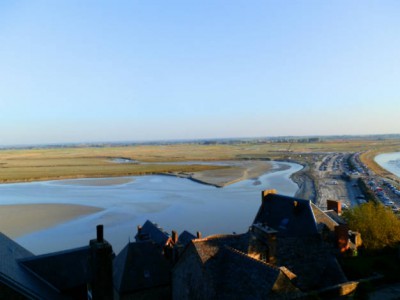BAY OF MONT SAINT MICHEL, FRANCE. The English Channel is remarkably rough, separating France from England by a few hundred miles. Many beaches are darkly stained with churned sediment, or rounded pebbles of grey and blue. At the Bay of Mont Saint Michel, the tide swirls around the namesake fortress, a vestige of medieval France. It is a towering stone abbey carved upon a mountain, rising to the Catholic arc angel Saint Michel, down to the perilous bay of quicksand, and surrounding fields of salty grass that supposedly tenderize the grazing lamb and sheep.
I’ve been there three times: first as a sophomore in high school, on an eye-opening 10 day exchange; again as a senior, retracing my steps and finding new passageways and foods to try; and as a sophomore in college in 2011, I spent an entire semester in France based out of Rouen, the capital of Normandy. Why did I return to France, when I could have studied abroad somewhere else? It was the prospect of linguistic fluency after studying for eight years, the cool non-chalance of French-girl style, the joie de vivre of afternoon cafés; the culture tugged me in so many ways, including my stomach. France has a world-renowned food culture, to the extent that UNESCO declared it ‘World Intangible Heritage’ in 2010. At the end of September our class toured through the northern regions, and where did we go, but the quintessential Mont Saint Michel. There I was, straddling the border of Brittany, Normandy, and the English Channel, visiting the Mont Saint Michel for the third time, poised to conquer not only the Mount, but my own Francophile, gastronomic aspirations.
Once the sun set and our bags were stored at the narrow rooms of Auberge Saint-Pierre, we squeezed around two back-to-back tables at the downstairs restaurant for dinner. Recessed lamps and pretend candelabras glowed jovially on the wall with cement and stone, exposed wooden beams, heavily adorned chairs, hanging copper pots, porcelain tableware, and waiters in formal, tucked in uniforms. There were moules marinières, fish soup, huîtres creuses, raw ham from the countryside, or salade Niçoise to start; the main dishes included skewers of beef, barbecue pork ribs, chicken cutlets in a cream sauce, grilled salmon béarnaise, pasta, or a roasted leg of lamb—yes, one of those infant sheep we saw in the pastures alongside the roads to the Bay. Dessert always meant a conflict of interest between French cheese, in all of its oozing, biotic, creaminess; or, a sweetly glazed fruit tart that aligned the tendencies of American palates. My classmates and I, tantalized by every choice, acted accordingly. We each ordered a different combination so that they would all appear on the table to share—democratic eating, we called it.
A steaming pot of shellfish of every size and shape was placed in front of me by one of the waiters, wafting garlic, sage, and the salty bay. I never liked eating shellfish until I visited France. The small, round, fleshy knobs of scallop that my mom used to extract from a can of brine were anything but palatable. As a child, I was interested in prying open the shells of oysters and mussels, but never I actually intended to ingest them. It seemed like spoiling some secret of the sea, one that wasn’t necessarily supposed to be shared.
I took my petite three-pronged fork and jabbed at what could best be described as a snail shell and extracted the meat. The taste was everything I smelled, but more rich, savory, and juicy. Despite that only this mid-range tasting menu was at our disposal, reflecting the tactics of a three-star hotel that needed to temper its snobbery for tourist-plebeians such as ourselves, this must have been the France that turned U.S. compatriots into Francophiles. The ambience, the company, the murmured French, the neatly arranged plate, and even the stiff waiters created a moment worth savoring. I opened an oyster next and as I chewed on the meat, an image of Brittany came to mind: mercantile mariners, cliffs and capes, waves of independence, and the Celtic ambiguity of Breton language.
Suddenly I knew why the Bretons were known as outliers of the far West, why their livelihoods were entwined with the sea, why outward appearances, a bit tough to penetrate and hardly charming, could actually be the shell for hundreds of years of history, customs, and lifestyle. For me, the degustation of shellfish at Aubege Saint Pierre was the magnifying moment for my understanding of regional gastronomy and identity in France; for the Bretons, this was daily dinner fare. If it was French culture I was looking for, I had found it on my plate.
***
Some tips: To reach the Mont Saint Michel, the best option is to take a car on the A84 Caen-Rennes highway. There are no buses that directly lead there, but the TGV high speed train departs from Paris to Rennes, then to Pontorson-Mont St Michel train station 4 times a day, with just a brief bus ride afterwards to reach the Abbey. The price for a single admission ticket over the age of 25 is 9 Euros; with a student ID, entrance costs 5,50 Euros; EU citizens and those under the age of 18 are free. Group discounts are also available. Various museums within the Abbey are an additional 9-18 Euros. Dinner at Auberge Saint-Pierre from the prix-fixe menu is between 20-45 Euros, while lodging there ranges from 150-300 Euros per night for two adults. Although the meal was enjoyable to splurge, for a day trip it’s also possible to carry in a small picnic then take out the trash.
More information at the Official Tourism Website.


